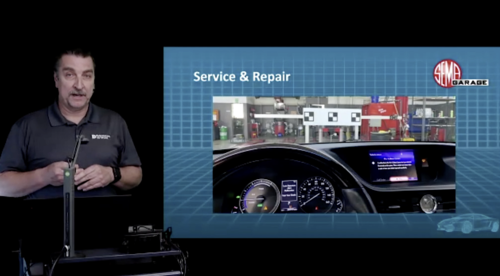By Ashley Reyes

provides viewers an overview of the technology, along with tips for
successful product development, testing and calibration.
The slightest modification to an ADAS-equipped vehicle—a new layer of window film, for example, or a freshly painted bumper—can potentially affect an ADAS system’s ability to function as intended by the OE manufacturer. Further complicating matters is the lack of any standardized industry protocols regarding sourcing, positioning and calibrating these systems. To the aftermarket manufacturer looking to R&D new products to integrate with ADAS sensors, or the repair shop tasked with installing and testing them, the learning curve can seem steep indeed.
To help demystify ADAS and shed light on what can seem to be an impenetrable subject, SEMA members are invited to attend a three-part SEMA Virtual Education webinar series focused on ADAS and the aftermarket. Moderated by Mike Spagnola, SEMA vice president of OEM and product development programs, the series provides an overview of ADAS while offering expert service and troubleshooting tips from a panel of industry professionals.
The first episode, “ADAS Technologies: Real World Systems and Trends” streamed in mid-June and offered an overview of the technology and featured a lively Q&A session. Among the topics discussed were:
- How can you tell what ADAS systems are on a given vehicle? Does the vehicle VIN work, or is there another resource?
- What specific tools and equipment are needed?
- How does windshield protection film affect sensor or camera functions?
- Will smaller calibration targets become OE-acceptable or certified?
To learn more about these subjects and to view a recording of the presentation, visit the SEMA YouTube Channel.
Because most ADAS products rely on sensors that are very precise, aftermarket products for vehicles equipped with ADAS must be rigorously tested. Depending on the ADAS on the vehicle and the aftermarket product involved, different tools and test methodologies may be required.
Part Two of the series, “Making Sense of Simulation, Testing and Calibration,” takes place on Wednesday, June 30, at 11:00 a.m.–12:30 p.m. (PDT) and will feature a panel of experts who will answer attendees’ questions while sharing resources that SEMA members can utilize to develop, test and install parts successfully while maintaining the OEM functionality of the ADAS system.
Register for ADAS Technologies: Making Sense of Simulation, Testing and Calibration.





